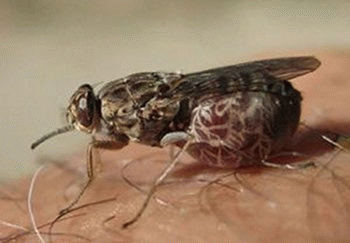Bacterial, parasitic infections on the increase?
A high-profile donation from the
Bill and Melinda Gates Foundation has thrown a new spotlight on neglected
tropical diseases although many fear progress toward eliminating some of these
diseases could be scuppered by climate change.
The neglected diseases are a
group of chronic, disabling conditions ranging from bacterial and parasitic
infections to snakebites that affect more than a billion people worldwide.
These diseases contribute to an ongoing cycle of poverty and stigma, with many
infected people unable to work or attend school. Controlling them will be
critical to the health and economic growth of developing countries - which are
also disproportionately vulnerable to climate change.
“There’s a great deal of
uncertainty, said Mark Booth, deputy director of the Wolfson Research Institute
for Health and Wellbeing at Durham University in the UK. “We’re not sure how
much climate change will affect [disease] transmission rates. We’re not sure
what will happen with the environment and how people and governments will
adapt.”
Opinion divided
Many researchers are concerned
that changes in rainfall patterns could result in a loss of “endemic stability”
for diseases carried by mosquitoes, ticks and other disease hosts, and that environmental
conditions could become favorable for disease transmission.
Rising average annual
temperatures have already been blamed for increasing numbers of malarial
mosquitoes at higher altitudes in Tanzania and Kenya. Increasing numbers of
malaria cases have also been reported in the highlands of Madagascar, Rwanda
and Ethiopia. While malaria is not considered an neglected disease, similar
patterns of expansion are feared for other tropical diseases carried by
mosquitoes and flies. Temperature, rainfall and runoff could also affect the
growth and spread of microbial diseases.
But many researchers believe
there is simply not enough information available to warrant alarm. Speakers at
the International Society for Neglected Tropical Diseases (ISNTD) Bites
conference in London in October, were divided over the extent to which climate
change is already having an impact on NTD control and whether it should be
given priority over other disease drivers.
“Unfortunately I think the
discussion has got into a rather unconstructive, polarized debate,” said World
Health Organization (WHO) senior scientist Diarmid Campbell-Lendrum. “There are
those on one side that blame all changes in NTDs on climate change - a disaster
scenario - and those that think climate change has nothing to do with it at
all.”
He continued: “I think climate
change really has to go in to the mix of all of the things that we need to
consider. Nobody disputes that there is evident climate sensitivity in some of
these diseases, so it would be illogical to exclude it.”
Research needed
Booth is calling for more
research. “My feeling is not enough attention is being paid to climate change
in relation to NTD control,” he said. He believes that climate change is “so
complex that no one discipline - epidemiologists, ecologists, climate
scientists - will be able to work it out.”
Booth describes a “paucity” of
information, emphasizing the need to increase field work on environmental
changes and to create a more robust surveillance system for NTDs.
Courtney Murdock, a researcher at
Pennsylvania State University, echoed these sentiments. “We don’t have enough
of an understanding of the basic ecology of mosquitoes and their parasites - we
still don’t know much about how they interact with the environment and how
changes to microclimate will impact their physiology, development in larvae
stage, their biting range, etc.,” she said. “Some of this work has already been
done in the lab, but we need to move this into the field.”
Sleeping sickness is a parasitic disease transmitted
by the bite of the tsetse fly
Other human factors
Climate change, caused by the
release of human-produced greenhouse gases into the atmosphere, is expected to
have wide-reaching effects in relatively short order. But other human factors
are sure to have an effect on the spread of NTDs as well.
Alan Fenwick, a professor of
tropical parasitology at Imperial College London, said that everyone working in
his field “is aware of climate change.” But, he said, “in my opinion, more of
what we’re seeing at the moment that impacts these diseases is man-made - so
we’re talking about, for example, changes in water distribution, irrigation
schemes… We also see increasing urbanization, with more people moving in to
cities.”
Julian Entwistle, from pest
management business consultancy Xenex Associates, believes there is evidence
challenging the notion that climate change will lead to the rapid expansion of
some NTDs, and says the movement of goods should be considered foremost among
the drivers of vector-borne diseases.
The international trade in car
tires, for example, facilitates the spread of mosquitos that carry dengue fever
and other illnesses; the water that accumulates in tires offers a breeding
ground for the insects. To control the spread of these diseases, said
Entwistle, tire importation could be regulated and storage locations reported
and inspected.
Additionally, many NTDs are
linked to poor sanitation, meaning advances in living standards could mitigate
their spread. “Movements into areas of relative affluence - that have running
water and sanitation - we know can stop NTDs. But if [people] are moving into
packed slums, this has the opposite effect,” Fenwick said.
But in most cases, the
consequences of human activity are simply unknown. Here, too, better research
networks and disease surveillance will be essential.
“Although the argument over
determinants is scientifically interesting, what we really need to do is fund a
stronger disease control program that’s more robust in response to increased
risk," said WHO’s Campbell-Lendrum.
IRIN
(IRIN is a news service of the United Nations Office for the
Coordination of Humanitarian Affairs. Its views do not necessarily represent
those of the UN)



No comments:
Post a Comment